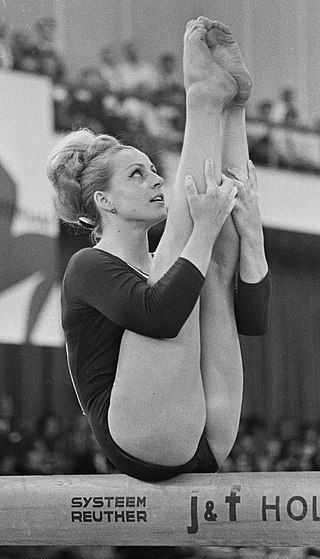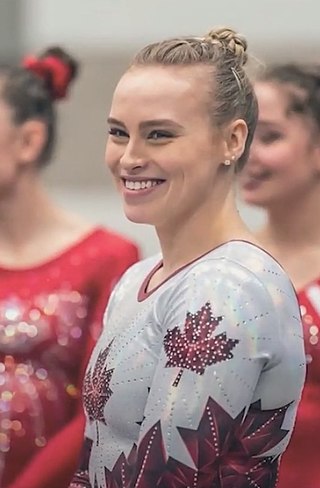
Věra Čáslavská was a Czechoslovak artistic gymnast and Czech sports official. She won a total of 22 international titles between 1959 and 1968 including seven Olympic gold medals, four world titles and eleven European championships. Čáslavská is the most decorated Czech gymnast in history and is one of only two female gymnasts, along with Soviet Larisa Latynina, to win the all-around gold medal at two consecutive Olympics. She remains the only gymnast, male or female, to have won an Olympic gold medal in each individual event.
Artistic gymnastics is a discipline of gymnastics in which athletes perform short routines on different apparatuses. The sport is governed by the Fédération Internationale de Gymnastique (FIG), which designs the Code of Points and regulates all aspects of elite international competition. Within individual countries, gymnastics is regulated by national federations like British Gymnastics and USA Gymnastics. Artistic gymnastics is a popular spectator sport at many competitions, including the Summer Olympic Games.

Vlasta Děkanová was a Czechoslovak artistic gymnast. She was the first World all-around champion in women's artistic gymnastics.
The Artistic Gymnastics World Championships are the world championships for artistic gymnastics governed by the Fédération Internationale de Gymnastique (FIG). The first edition of the championships was held in 1903, exclusively for male gymnasts. Since the tenth edition of the tournament, in 1934, women's events are held together with men's events.
The men's team competition was an inaugural event at the World Artistic Gymnastics Championships. It was not held in 1992, 1993, 1996, 2002, 2005, 2009, 2013, 2017, and 2021. In 1994, a separate team championships were held, apart from the individual events championships. This was the only year such a separation was made.
The men's individual all around event was an inaugural event at the Artistic Gymnastics World Championships. It was not held in 1992, 1996, and 2002.
The men's pommel horse competition was an inaugural event at the World Artistic Gymnastics Championships. It was not held in 1909.
The men's still rings competition was an inaugural event at the World Artistic Gymnastics Championships. It was not held in 1905 and 1907.
The men's parallel bars competition was an inaugural event at the World Artistic Gymnastics Championships. It has been held in every year since its inception.
The men's horizontal bar competition was an inaugural event at the World Artistic Gymnastics Championships. It has been held in every year since its inception.
Women's events at the Artistic Gymnastics World Championships were first held in 1934 at the 10th World Championships. Only the All-Around and Team events were held. In 1950, at the 12th World Championships, the other apparatus events were added.
Women's events at the Artistic Gymnastics World Championships were first held in 1934 at the 10th World Championships. Only the All-Around and Team events were held. In 1938, at the 11th World Championships, the other apparatus events were added.
Women's events at the Artistic Gymnastics World Championships were first held in 1934 at the 10th World Championships. Only the All-Around and Team events were held. In 1938, at the 11th World Championships, the other apparatus events were added. Originally women participated at parallel bars competition. Starting from 1950, at the 12th World Championships, it was replaced with uneven bars competition which has been held in every year since its inception.
Women's events at the Artistic Gymnastics World Championships were first held in 1934, at the 10th World Championships. Only the All-Around and Team events were held. In 1938, at the 11th World Championships, the other apparatus events were added.
Women's events at the Artistic Gymnastics World Championships were first held in 1934 at the 10th World Championships. Only the All-Around and Team events were held. In 1938, at the 11th World Championships, the other apparatus events were added.
The 11th Artistic Gymnastics World Championships were held in Prague, Czechoslovakia, in 1938.

Elsabeth Ann Black is a Canadian artistic gymnast. She is a three-time Olympian, having represented her country at the 2012, 2016, and 2020 Olympic Games. She is the 2017 World all-around silver medalist, making her the first Canadian gymnast to win a world all-around medal, and she led the Canadian women's gymnastics team to a bronze medal in the 2022 World Championships team final, the first world team medal won by a Canadian gymnastics team. She won a silver medal on the balance beam at the 2022 World Championships. She is also the 2018 Commonwealth Games all-around champion, a two-time Pan American Games all-around champion, and a six-time Canadian national all-around champion. At the 2020 Olympic Games, Black placed fourth in the balance beam final, the highest placement in the Olympics for a female Canadian gymnast.

Janina Skirlińska was a Polish artistic gymnast who competed at the 1936 Summer Olympics. She was a member of the Polish women's team at those Olympics, where they placed 6th in the team competition.
FIG World Cup refers to a number of events organized by the International Gymnastics Federation (FIG) across seven competitive gymnastics disciplines: 1) acrobatic gymnastics, 2) aerobic gymnastics, 3) men's artistic gymnastics, 4) women's artistic gymnastics, 5) women's rhythmic gymnastics, 6) trampoline and tumbling, and 7) parkour.





